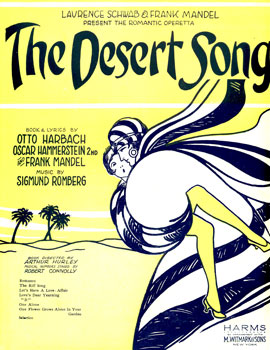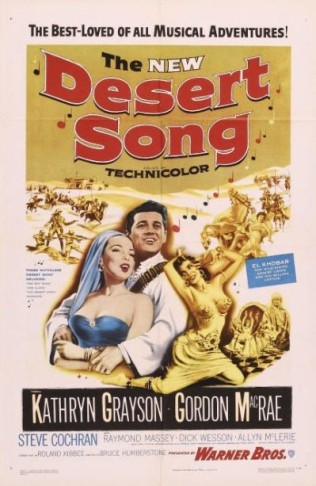Kurt Gänzl
The Encyclopedia of the Musical Theatre
1 January, 2001
The most internationally successful and the most enduring of Sigmund Romberg’s long line of romantic musical plays, The Desert Song opened on 30 November 1926 at the Casino Theater, New York. It was – so it was seriously said – based on the doings of a genuine Berber chieftain (it was later that Arab’s chief qualification for a New York Times obituary), but its tale of romance and disguise, deftly mixed with the standard amount of parallel comic action, as put together by Oscar Hammerstein II, Otto Harbach and Frank Mandel ran smoothly in the regulation comic opera groove and, if anything, seemed to owe much more of its colour and its incidents to the recent Hollywood success The Sheik (1922) than to Morocco’s publicity-hungry desert murderers.

Original sheet music cover from 1926.
The anti-French Arab guerillas of the North African deserts who have been raiding and pressuring the colonial government, as represented by army chief Captain Paul Fontaine (Glen Dale) and the new Governor, General Birabeau (Edmund Elton), are led to damaging effect by a mysterious person known as the Red Shadow. In fact, the Red Shadow is none other than the Governor’s native-loving son, Pierre (Robert Halliday), who pretends to be a weak-witted fool at home whilst secretly sneaking out to put on Arab garb and lead the locals’ attacks on his father’s forces. His gormless act means that he has little chance of winning the lovely Margot Bonvalet (Vivienne Segal) from Fontaine, so to pursue his suit he gets into his sheikish costume and carries her romantically off into the desert. When General Birabeau comes to free her, Pierre is unable to draw his sword against his father and thus forfeits his leadership of the Arab band. But later, when Fontaine has set forth to take the Red Shadow, dead or alive, the jealous Arab dancing girl, Azuri (Pearl Regay), reveals to the General that he has put a price on the head of his own son. But the ending is happier than Il Trovatore: Pierre produces the Red Shadow’s costume and announces that he has killed the rebel. Only his father and maybe — just maybe — Margot, need know the truth. The comic element was provided by Bennie Kidd (Eddie Buzzell), a society columnist deputizing uncomfortably as a war correspondent, and his desperately devoted secretary, Susan (Nellie Breen).

Postcard with scnes from the original Broadway production 1926.
Romberg’s score contained several songs which were to become romantic standards — the hero’s waltzing invitation to Valentino-style desert bliss in `The Desert Song’ (`Blue heaven, and you and I …’), Margot’s soprano dreams of Elinor-Glynnish `Romance’, the driving chorus of `The Riff Song’ and the Red Shadow’s ballad, `One Alone’, which was one part of an impressive `Eastern and Western Love’ section which also included the lovely `Let Love Go’ and the counter-tenor `One Flower Grows Alone in Your Garden’. A pretty `Why Did We Marry Soldiers?’ and French Marching Song for the ladies’ chorus, a lightly humorous demonstration of tough seduction techniques (`I Want a Kiss’), and the heroine’s showpiece Sabre Song were amongst other highspots of a score in which the straight comedy numbers — Bennie’s musings over the feminine quality known as `It’, his fears, under pressure from a saucy Spaniard (Margaret Irving), that he will soon be `One Good Man Gone Wrong’, and Susan’s `I’ll Be a Buoyant Girl’ — were slightly submerged.
The libretto of The Desert Song was, give or take a sag in the last stages of the second act, very much better made than those for most contemporary musical romances, and the show’s emphasis on the sentimental and seductive side of its content, richly illustrated musically, proved to be well in the line of current taste. Schwab and Mandel’s production of The Desert Song (prematurely entitled Lady Fair on its initial showing at Poli’s Theater in Washington) was a great Broadway hit through a run of 471 performances, as the preface to a very long career.

Poster for the 1929 film version.
London’s Theatre Royal, Drury Lane production with Harry Welchman (Pierre) and Edith Day (Margot) starred, Maria Minetti as Clementine and Clarice Hardwicke as Susan, echoed the popularity of the Broadway edition with a splendid run of 432 performances, and the show was soon on the road for what would be the first of a seemingly interminable number of tours in both countries. In Australia, too, where Lance Fairfax introduced the exploits of the Red Shadow alongside Virginia Perry (Margot), Herbert Mundin (Benny), Peter Gawthorne (Birabeau) and Stephanie d’Este (Azuri) in J C Williamson Ltd’s production, the piece was a huge hit. It ran some 220 performances in its initial season in Melbourne, and, with Marie Bremner succeeding to the rôle of Margot, some five months in Sydney (Her Majesty’s Theatre 30 March 1929), becoming a perennial and oft-reproduced favourite with which its star (and his entrance on horseback) was identified ever after.

“One Alone” from the 1953 film version.
Whilst, in America, The Desert Song returned only once, and briefly, to Broadway (Uris Theater 5 September 1973) as well as to the repertoire of the New York City Opera, in Britain a number of further metropolitan appearances followed the first. Alec Fraser and Sylvia Welling starred in a 1931 reprise (Alhambra Theatre 8 June), the original stars returned to the London Coliseum in 1936 (24 September), and Bruce Carfax and Doris Francis featured in a 1939 revival at the Garrick Theatre (29 June). Welchman made a third London appearance as the Red Shadow, this time paired with Eleanor Fayre, at the Palace Theatre in 1943 (16 January) and in 1967 provincial favourite John Hanson braved London, paired with soprano Patricia Michael, for a 383-performance run at the Palace Theatre.

Another poster for the 1956 film version.
Unlike its near contemporary Rose Marie, The Desert Song did not make major inroads into Europe, with one exception: France. After the serious success of Rose-Marie, the Isola Brothers had followed up with Hallelujah! (ie Hit the Deck) with much more mitigated results. They hastened to mount another American romantic piece and Le Chant du désert (ad Roger Ferréol, Saint-Granier) produced as an `Opérette à grand spectacle en 2 parties et huit tableaux’ served their purpose well. Robert Couzinou (Pierre) played l’Ombre Rouge, Marcelle Denya was Jenny (ex-Margot) singing `Rêver’, whilst the comic Dorville was Onésime (ex-Bennie) in his quest for `Ça!’. The production had a seven-month career, and though it did not come near challenging the remarkable success of Friml’s piece in France, it survived well enough to be seen in revival at Lille’s Théâtre Sebastapol as recently as 1994 (24 April).
The Desert Song made its way briskly on to film, with John Boles appearing in ‘the first all-singing-and-talking operetta’ as the Red Shadow to the Margot of Carlotta King and with Myrna Loy (Azuri), Edward Martindel (Birabeau), Louise Fazenda (Susan) and Johnnie Arthur (Bennie) featured, in the first of three Warner Brothers films (1929). Dennis Morgan and Irene Manning paired for a second version in 1943, and a third, a decade later, featured Gordon MacRae and Kathryn Grayson. Warners also issued a 20-minute potted version in 1932. An NBC television broadcast of 1955 gave Nelson Eddy an airing as the Red Shadow.
Three-quarters of a century on, The Desert Song remains in the repertoire in English-speaking countries and, beyond American shores, it shares with Rose Marie and with the increasingly fashionable Show Boat the representation of its era of American romantic musicals.
UK: Theatre Royal, Drury Lane 7 April 1927; Australia: Her Majesty’s Theatre, Melbourne 15 September 1928; France: Théâtre Mogador Le Chant du désert June 1930;
Films: Warner Brothers 1929, 1943 and 1953
Recordings: selections (HMV, Capitol, RCA, Columbia, Decca etc), selection in French (TLP)

Does a filmed version of the stage production exist ? If so how is it possible to purchase a copy. Many thanks, JH
Is there a recording of a stage production available, and if so where?
There are various recordings, some based on stage casts. But they are all studio recordings, it seems. And there doesn’t see to be a recording from recent years.